Appreciating the Cloisonné Enamel from the Qing Palace: Buddhist Temple Supplies and Daily Necessities

Ⅰ. Buddhist Temple Supplies
The rulers of the Qing Dynasty were deeply devoted to Buddhism, and Emperor Qianlong, in particular, was a strong believer in the Yellow Sect of Tibetan Buddhism, also known as the “Lamaist” tradition.
During the Qianlong period, as the central government in China gradually stabilized, strengthening control over the border regions, including Mongolia and Tibet, became a key priority. Drawing lessons from both ancient and contemporary history, Emperor Qianlong made the Yellow Sect, which was widely practiced in the Mongol and Tibetan areas, the state religion. He believed that “the maintenance of the Yellow Sect in our dynasty is due to the fact that the Mongols have long been adherents, and it serves as a respectful and practical measure,” meaning that by promoting the mainstream religion in these border regions, the Emperor sought to harness the influence of religious leaders to curb secular power and further strengthen his rule over the Mongol and Tibetan territories.
At that time, the state’s favoring of Yellow Monks was not just for the sake of worshiping their teachings to seek blessings, but more importantly, it reflected a political strategy. Since the Mongol tribes had long revered the Yellow Sect, the government used it as a means to guide and influence them, hoping to gain their genuine submission and thereby strengthen the frontier defense. By the later years of the Qianlong era, the emperor became more devoted to Buddhism, even writing a poem that said, “Although the statue is made of wood and stone, sincerity and respect can connect with the divine.” As a result, numerous Buddhist halls were set up within the palace, each filled with various ritual vessels and Buddhist implements, such as the Seven Treasures, Eight Jewels, and Five Offerings. These items were made from a variety of materials, including gold, silver, copper, jade, porcelain, enamel, and lacquer. It can be seen that the emperor really liked the color yellow, after all, Chinese emperor outfit was yellow.
The image below shows the Qing Dynasty’s Great Vajra Mandala (大威德金刚坛城) and it’s Thangka (Buddhist banner).
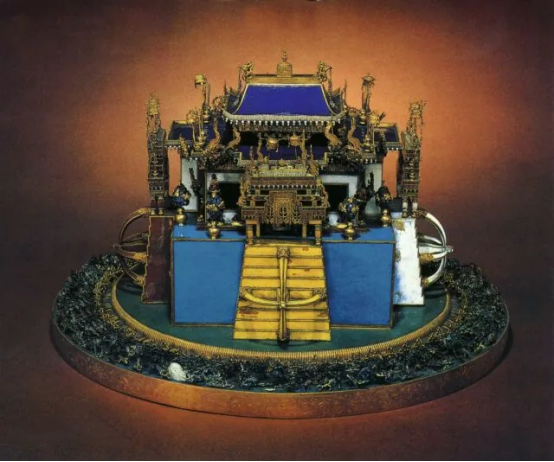
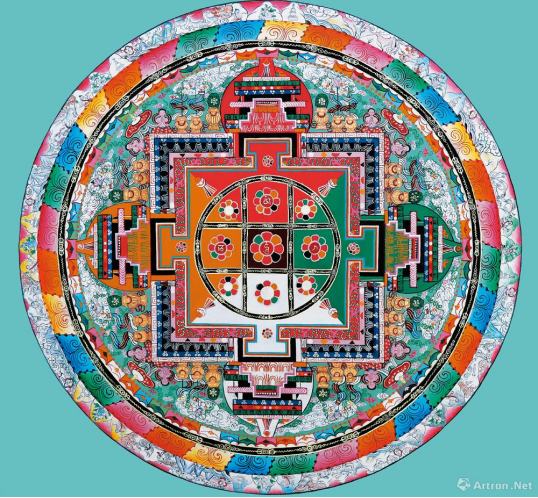
In terms of cloisonné enamel craftsmanship, during the mid to late years of the Qianlong reign, the Imperial Workshops produced numerous cloisonné items that were displayed in Buddhist halls. These included items such as bowls, the Five Offerings, the Eight Jewels, Mani stones, Buddha statues, Tibetan herb bottles, stupas, mandalas, and prayer wheels. Among these, the most famous are the grand cloisonné mandala in the Yuhua Pavilion and the twelve towering cloisonné Lama stupas displayed in the Fanhua Pavilion (梵华楼) of Qianlong Garden and the Baoxiang Pavilion of Cining Garden (慈宁花园宝相楼). These were crafted by the Imperial Workshops cloisonné in the 39th and 47th years of Qianlong, respectively.
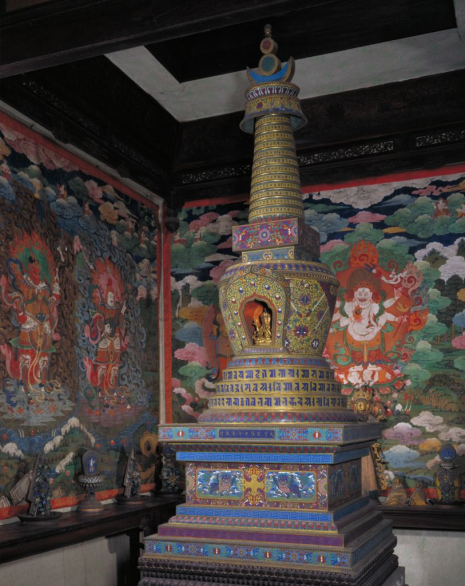
Ⅱ. Daily Necessities
The cloisonné enamel objects used in the palace can generally be divided into two categories: one is dining utensils, and the other is daily necessities, Qing Dynasty clothing is as elaborate and magnificent as these cultural relics.
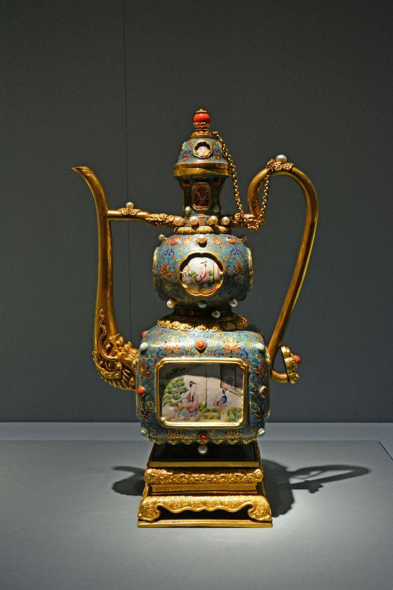
The dining utensils include bowls, plates, cups, teapots, Duomu pots, handle teapots, stacking plates, hotpots, chopstick holders, covered bowls, and more. A famous example is the gold-based cloisonné enamel teapot with a painted enamel depiction of a mother and child, crafted using both cloisonné enamel and painted enamel techniques. This teapot features a gourd shape with a rounded top and square bottom, with a golden dragon-shaped spout and a curved ruyi-style handle. The teapot rests on a copper base with gilded floral engravings. The body of the teapot is covered with blue enamel and decorated with cloisonné enamel lotus patterns in vibrant colors. Four symmetrical openings, each adorned with painted enamel plaques, depict Western ladies, rose-tinted landscapes, female figures, and courtyard scenes. The teapot is further embellished with pearls and coral, and the base is engraved with the inscription “Qianlong Year” in regular script. The piece is both magnificent and intricate, perfectly embodying the royal grandeur of the Qing Dynasty.
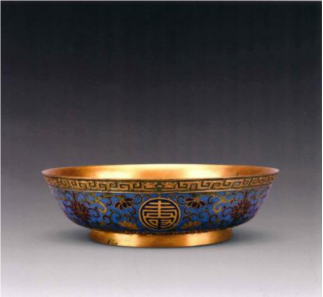
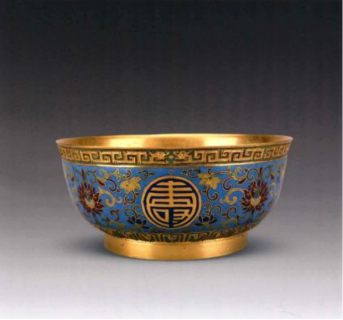
In the 45th year of the Qianlong reign, to celebrate the 70th birthday of Emperor Qianlong, the Imperial Enamel Workshop created a large number of cloisonné enamel “万寿无疆” (Endless Longevity) plates and bowls. The bottom of each piece was inscribed with the seal script “子孙永保” (May Descendants Always Be Protected). These cloisonné enamel items, centered around themes of longevity, good fortune, and prosperity, conveyed a beautiful vision for the nation’s continued prosperity and the enduring legacy of future generations.
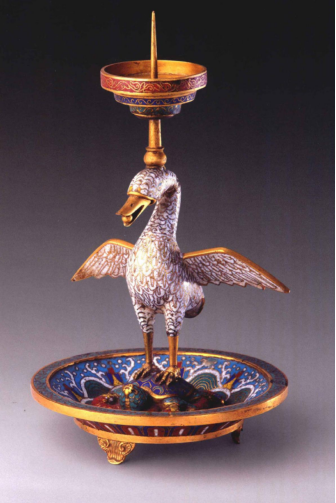
Another category is daily necessities, which come in a wide variety, including hand warmers, incense burners, spittoons, crown racks, candle holders, flower basins, snuff bottles, hooks, buckles, copper mirrors, ice boxes, and more. Among them, the cloisonné enamel “Hai Yan He Qing” (Peaceful Seas and Rivers) candle holder stands out with its unique design. The shallow plate of this candle holder features a turtle, a coiled snake, and water patterns. A goose, poised as if ready to take flight, stands on the turtle’s back, with a wax holder on top of its head where a candle can be placed. This candle holder is not only aesthetically pleasing and charming but also carries a symbolic meaning of good fortune, making it a quintessential piece in the imperial court style.

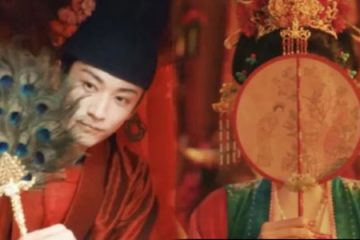
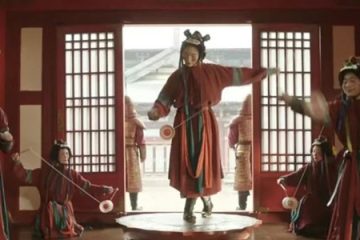
0 Comments